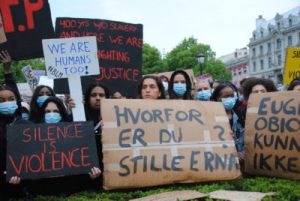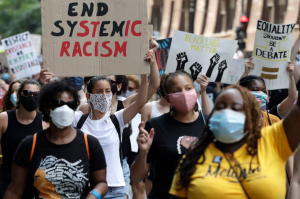
As I am writing this, merely 7 hours ago a hateful man of nordic descent threatened to shoot
two mosques in Norway, showing off the gun that he will use (@nightsofgnosis, 2024). In
March, the UN Working Group of Experts on People of African descent reported that racial
profiling, discriminatory acts, and hate speeches still happens often (United Nations Human
Rights Office of The High Commision, 2024 ). In 2022 alone there are 923 documented hate
crimes, 166% increase from 2015 (Dyvik, 2023). The Nordic countries, famed for their high
living standards, beautiful landscapes and their welfare system or the so-called ‘Nordic
Model’ are familiar among many. Yet, no system is perfect including their welfare system. In
this essay the writer argues that the Nordic Model is imperfect because of the latent fact that
those three aforementioned facts are still present, and will be too in the future unless there is a reform to the present institution and policy formation.
Welfare systems are good, there is no denying that the humanitarian and universal values that
the welfare system holds is beneficial to all. Though, we must remember that the welfare
system especially in the Nordic countries was made at a time where the framework is stanked
with a Neoliberal scent. Different from America, in Norway systematic racism is hardly
realised because of the low income inequality levels, but it is still there. An institution can be
structurally racist if tendencies of the racist and discriminatory kind are present while being
agreed upon by a relatively large group of interest in said institution, regardless of the
equality that the present law holds (Thomas et al., 2023). Therefore, the question “is Welfare
good?” is a rhetorical one, more accurately the question should be “Welfare for whom?”.

‘Racism’ has become a somewhat taboo topic in Norway and is generally looked down upon,
that is a bare minimum in our contemporary society. Yet the definition of racism that they
hold is a shallow, narrow and an all-around ancient definition of Racism, mainly that of only
biological racism, and they neglect cultural racism (Bangstad, 2015). This is not unique to
Norway, as waves of immigration struck Europe, overtime racist tendencies held sway among
policy makers and even those from ‘progressive’ parties (Bangstad, 2015). In Norway
specifically, the cultural differences are emphasised and take form to a somewhat neo-racist
environment, this happens especially to Muslims and immigrants of African descent. In fact,
it is common that citizens with foreign sounding names tend to get rejected more in job
vacancies rather than nordic sounding ones, get discriminated against in school, and get
harassed in everyday life (United Nations Human Rights Office of The High Commissioner,
2024). Immigration is an inseparable topic from racism, many argue that immigrants are a
parasite, stealing our welfare, while they are lazy and unproductive (Perocco, 2022). This is
cultural racism, people who aren’t ‘authentic norwegians’ are less likely to benefit from
policies that are inherently made and preserved by those that ‘authentic norwegians”, this
welfare chauvinism paradigm is ever present, they won’t consent on being called a racist, but
they will agree to an “us and them” narrative, that Nordic culture is the superior one
(Perocco, 2022). Those above mentioned sayings and paradigms are intertwined with the
policy formation in Norway that was once an adoption of socialism, but nowadays it is made
on the international neoliberal framework, that reorganises and transforms racism to better
suit its purpose of capital accumulation (Perocco, 2022). With that model, they often neglect
the social factors that are inherently important. Thus, reducing people to mere numbers and
preserving a racial based labour market and the surplus of labour so that the exploitation that
are present aren’t hindered, made more optimal and accelerated (Perocco, 2022). Policy
formation is commonly separated into two approaches, one of a cold scientific and
technological approach, and a parallel literature that derives from the social sciences and puts
emphasis on the social-political. It is high time that policy formation changed and used the
latter approach, rather than the former (Rust, 1990). This is where intersectionality comes
into play, essentially intersectionality is an analysis of the multidimensionality of
marginalised subjects’ lived experiences (Nash, 2008). In policy formation, intersectionality
is able to put forth the often marginalised voices of the oppressed, by bringing various
dimensions that are rarely seen in policy formation, and is able to be the medium of which
marginalised people who experienced varying forms of oppression gets represented, therefore
leads to a more efficient, inclusive and effective policy formation (Rust, 1990).
Do not be mistaken, Welfare is good, but it is not infallible. The values that a Welfare State
holds indeed are great for all, yet in its practice flaws are still everpresent, no system is
perfect, and many argue that Welfare is the closest system to reaching social equality, with its
compromise of capitalist innovation and socialist egalitarianism. Yet, if we continue to create
that system based on neoliberalism, injustice will always be there, because the neo-liberal
state is a racist state (Kundnani, 2021). Intersectionality must be added to the system by
way in its policy formation and implementations, if not then the writer fears that the
exploitation will worsen and diversify, slowly but surely unless a reform is implemented.
Author: Muhammad Ilyan Faris
Editor: Ariefah Amini, Debby Salsabila
References:
